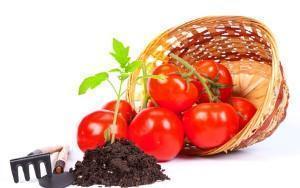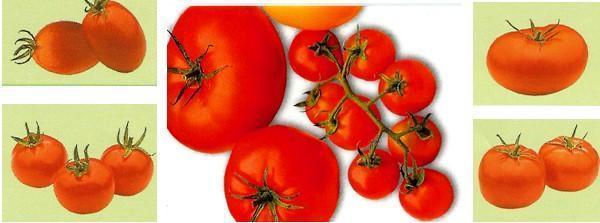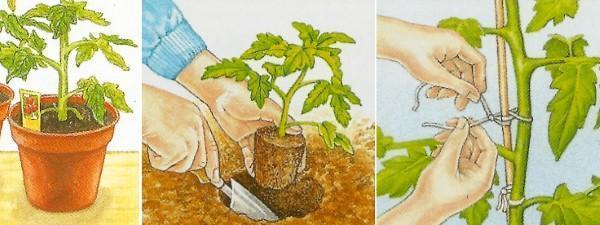How to grow tomato seedlings at home?
 Every novice gardener can grow an excellent tomato harvest at home without outside help, observing all agrotechnical norms for sowing, diving and planting seedlings. Only by ensuring the correct vegetation regime for the development of an annual plant can one expect an excellent result of one's work on a personal plot.
Every novice gardener can grow an excellent tomato harvest at home without outside help, observing all agrotechnical norms for sowing, diving and planting seedlings. Only by ensuring the correct vegetation regime for the development of an annual plant can one expect an excellent result of one's work on a personal plot.
The key to a big harvest is always in the quality of the seeds. Before sowing these, you need to decide on the varieties of tomatoes, the timing of their ripening and the temperature conditions for sowing.
Varietal classification of tomatoes
It should be borne in mind that tomatoes are classified according to stem height, fruit shape and ripening time. Among the most popular high-yielding modern varieties that take root in our natural and climatic conditions are:
- small-fruited - Sweet 100, Evita, Mirabell;
- medium-sized - Martina, Goldene Koeniging, Harzfeuer, Balkonstar;
- plum - Roma, San Marzano;
- large-fruited - Master, Beefmaster, Supermarmande.

Each land owner chooses a variety of tomatoes for planting based on the meatiness and elasticity of the fruit for further use on the farm - canning, sandwiches, salads or making sauces.
Before planting, it is worthwhile to decide in advance on the classification of the variety as a determinant or indeterminate species. The first option involves the development of low-growing plants, the second is prone to forcing the stem of more than two meters. This aspect implies completely different agrotechnical conditions for growing tomatoes in the open field.
Preparation of seed material and the timing of sowing tomatoes for seedlings
Planting tomato seeds for seedlings begins with the preparation of seed material, in particular, soaking the seeds in room temperature water with the addition of flower fertilizers and growth stimulants. The proportions of the preparations are always indicated on the packages.
After bubbling, the seeds are spread in one ball on a damp gauze folded in several layers, and covered with the same materials in order to create a warm vacuum at a temperature of 30 ° C with the creation of an effective air exchange. After a couple of days, wet and warmed seeds swell and the first buds are expelled.
Seeds are sown into the soil in early March or early April. Growing tomato seedlings in a greenhouse results in earlier seeding. For forcing the steams, you need a tray, the dimensions of which are selected depending on the expected amount of tomato seedlings grown. This can be a rectangular flower pot bought in a supermarket, or an unnecessary old vessel in the form of a metal or plastic basin.
The sowing container is filled with loose soil mixed with compost. You can buy loose humus in a specialized store, or you can cook it at home in the autumn.
The poured soil layer should not exceed fifteen centimeters, this height will provide optimal moisture saturation, and will not create an excess of it. Sowing tomato seeds for seedlings is carried out at the rate of one seed per three square meters. see land. The layer covering the sown seeds should not be dense and thick. The ideal option is 2-3 millimeters.
After the end of the seeding procedure, the container is placed in a warm place and the first shoots are expected.When these appear, it is necessary to take care of effective lighting of the place where the container is installed, since a thermophilic plant getting enough light, will form not only the stem, but will give all the strength to the leaves, which will ensure subsequently strong and hardy seedlings.
At the beginning of forcing, the first two leaves are formed on the stem. It is from this moment that intensive lighting of the shoots begins in order to effectively form the root system by plants and harden them - taking them out into the street for several hours, increasing the time by twenty minutes every day. With the growth of shoots, the time for seedlings on the street also increases.
Planting tomato seedlings in a greenhouse
After hardening procedures at 60 days of age, the seedlings can be planted in a pre-prepared greenhouse, in which the soil for tomatoes should be similar in structure to the soil in the seedling growing tray. The main useful property is the saturation of the soil with the necessary microelements that can determine the conditions for the growth of strong and fruiting stems. The greenhouse should have a collapsible design, since after the tomatoes are planted in the ground, the process of getting used to the natural climatic conditions will continue.
Many professionals in the agronomic field advise sowing seeds in the greenhouse right away. This makes it possible to simplify the task of growing seedlings, their hardening and picking at times.
Pickling tomato seedlings
Growing tomato seedlings at home may involve planting them in open ground without the use of greenhouse structures. For this, the sown material at the age of 30 days is subjected to picking, transplanting into separate pots in order to develop a strong root system of a separate stem. After the end of the late frost period, the dived seedlings are planted in fertilized soil, immersing the stem to the first lower leaf. If the seedlings have long stems, you should pay attention to their garter to a stably stable support, which can serve as an ordinary wooden glazing bead.

After the seedlings have begun at the landing site, it is worth regularly monitoring the appearance of new shoots with already developed leaves. These sprouts should be removed in order to further form a strong tomato root system.

To ensure a high future yield of growing tomatoes, you should not miss the appearance of four shoots on the seedlings and remove the tops.
Top dressing of tomato seedlings
The initial fertilization of the soil for tomatoes requires a sufficient amount of humus in it. However, this is not at all sufficient to provide plants with the necessary micro and macroelements throughout the entire growing season of development and fruiting. If the soil contains a balanced composition of the necessary biological substances, then there are no problems with the growth of tomatoes. However, the ideal option is rarely found in nature, often the gardener has to independently monitor the state of the soil and plants, regulating the lack of useful components by applying top dressing.
The lack of certain types of elements is always characterized by external defective manifestations on seedlings:
- if the stems of the planted plants are thin, dense and acquire a purple color, while the plants are undersized and do not discard inflorescences for a long time, there is a lack of nitrogen, which can be replenished by the introduction of nitrogen fertilizers;
- if yellow and dark brown spots appear on the leaves of the seedlings, the foliage curls and dries up, while the stalks die - there is not enough magnesium for the tomatoes, due to which the so-called chlorosis develops;
- if the tops of the seedlings turn yellow, and the lower rows of foliage are still green, it is urgent to feed the tomatoes with calcium and iron;
- in cases of a long absence of inflorescences, it is advisable to add phosphorus fertilizers to the soil;
- with a lack of manganese, the seedlings fade, weaken and are not able to physically form inflorescences;
- the lack of boron contributes to the growth of many shoots from the rhizome when the main stem withers, the seedlings turn into bushy plantings.
Tomatoes are very whimsical to watering and saturation of the soil with useful components. A particularly useful component is ordinary wood ash, which must be present in tomato beds.
Pest control
 A very important point in growing seedlings is pest control. Aphids are especially dangerous for tomatoes, which devour foliage and inflorescences. Modern means of intoxication help to fight against it. An effective biological method for combating harmful insects is growing tomatoes in the same area with nasturtium or poppy, attracting other types of insects that destroy aphids.
A very important point in growing seedlings is pest control. Aphids are especially dangerous for tomatoes, which devour foliage and inflorescences. Modern means of intoxication help to fight against it. An effective biological method for combating harmful insects is growing tomatoes in the same area with nasturtium or poppy, attracting other types of insects that destroy aphids.
Tomato seedlings love bright sun, warm, well-ventilated places, protected from the sultry lunch heat, frequent watering of the stem base with room temperature water.
After reviewing the material and video tutorial, I will make several clarifications from my own experience. Everything is correctly said about preparing seeds for sowing. But currently there are branded seeds that have undergone pre-planting preparation. This information is on the bags. Such seeds are sown only dry. Second, if the seedlings are grown on a windowsill at home, then they need to be hardened only in the last weeks. Small seedlings need warmth and good lighting during the day. And outside at this time there is still a borderline temperature, otherwise the plant would have been planted, and not fiddled with seedlings. And one more experience. I also planted seedlings in milk bags and from under the juices, and wondered why the plants did not develop well until I found information. All food bags are covered from the inside with a layer of a special film to suppress the growth of bacteria. Then we reason. Our plants assimilate food only with the help of bacteria. There are not enough bacteria, food is not completely absorbed. I made control landings and made sure the information was correct. And the video shows that the seedlings are yellowish.